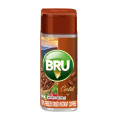 Loading... Please wait...
Loading... Please wait...- Home
- Spices & Blends
- Spices
- Turmeric (Curcumin)Whole 7oz- Indian Grocery,Spice,USA
Turmeric (Curcumin)Whole 7oz- Indian Grocery,Spice,USA
Product Description
Turmeric (Haldi)Whole.
Turmeric is an ancient spice, a native of South East Asia, used from antiquity as dye and a condiment. The name derives from the Latin terra merita “meritorious earth” referring to the colour of ground turmeric which resembles a mineral pigment.
In many languages turmeric is simply named as “yellow root”. Spice Description Turmeric is the rhizome or underground stem of a ginger-like plant. It is usually available ground, as a bright yellow, fine powder. The whole turmeric is a tuberous rhizome, with a rough, segmented skin. The rhizome is yellowish-brown with a dull orange interior that looks bright yellow when powdered. Bouquet: Earthy and slightly acrid. Flavour: Warm and aromatic with a bitter undertone.
Preparation and Storage Turmeric is mostly used in ground form. The powder will maintain its colouring properties indefinitely though the flavour will diminish over time so buy in moderation. Store in airtight containers, out of sunlight.
Culinary Uses : In India it is used to tint many sweet dishes. Apart from its wide use in Moroccan cuisine to spice meat, particularly lamb, and vegetables, its principal place is in curries and curry powders. It is used in many fish curries, possibly because it successfully masks fishy odours.
When used in curry powders, it is usually one of the main ingredients, providing the associated yellow colour. Attributed Medicinal Properties Turmeric is a mild digestive, being aromatic, a stimulant and a carminative.
An ointment base on the spice is used as an antiseptic . Turmeric water is an Asian cosmetic applied to impart a golden glow to the complexion. Curcumin has been shown to be active against Staphlococcus aureus (pus-producing infections).









